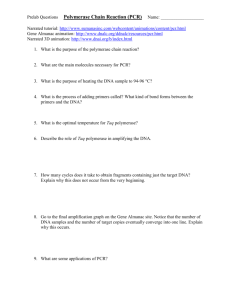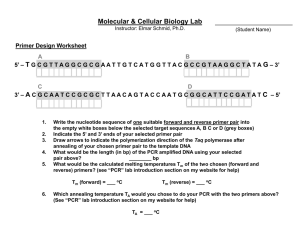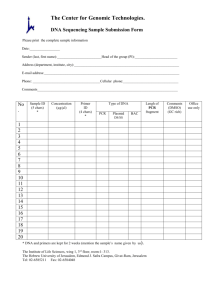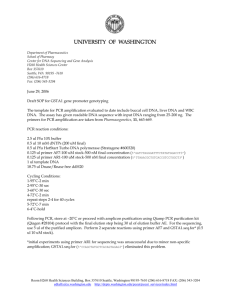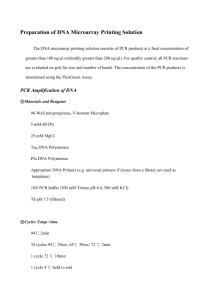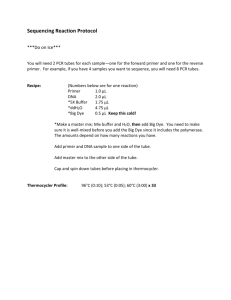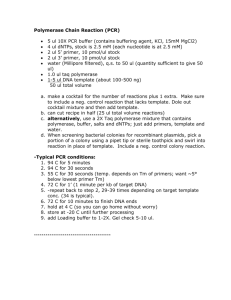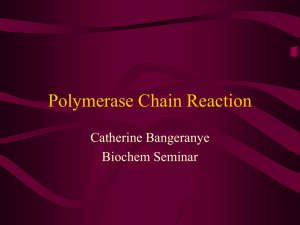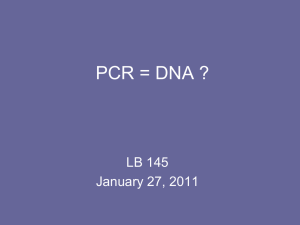Taq DNA Polymerase and PCR Kits
advertisement
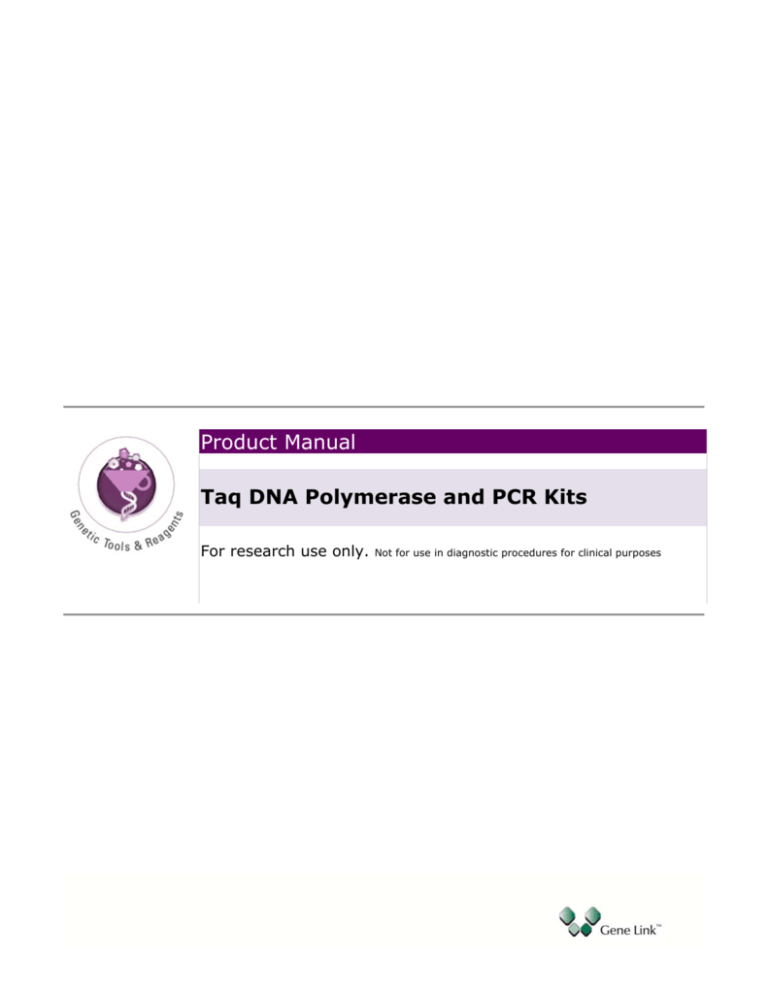
Product Manual Taq DNA Polymerase and PCR Kits For research use only. Not for use in diagnostic procedures for clinical purposes Polymerase Chain Reaction Products For research use only. Not for use in diagnostic procedures for clinical purposes. Material Supplied 40-5200-40 Taq DNA Polymerase; 400 units; 5 µ/µl 40-5211-01 Taq PCR Kit; 200 reactions 40-5212-01 Taq PCR Kit with controls; 200 reactions Taq DNA Polymerase is a thermostable DNA polymerase that possesses a 5´> 3´ polymerase activity and a double-strand specific 5´> 3´ exonuclease activity. It is the enzyme most widely used in PCR. Storage Instructions: Store at –20oC upon receipt. 40-5200-40 Taq DNA Polymerase 400 units; 5 µ/µl; 80 µl 40-5211-01 Taq PCR Kit; 200 reactions Catalog No. Unit Size Product Description 40-5200-30 300 units Taq DNA Polymerase 300 units; 5 µ/µl; 60 µl 40-3060-16 1.6 ml PCR Buffer Standard (10 X) 40-3061-16 1.6 ml PCR Buffer Mg Free (10 X) 40-3021-11 1.1 ml dNTP 2mM (10X) 40-3022-16 1.6 ml MgCl2; 25 mM 40-3001-16 1.6 ml Nuclease Free Water 40-3005-01 100 µl Omni-Marker™ Universal Unlabeled 40-5212-01 Taq PCR Kit with controls; 200 reactions Catalog No. Unit Size Product Description 40-5200-30 300 units Taq DNA Polymerase 300 units; 5 µ/µl; 60 µl 40-3060-16 1.6 ml PCR Buffer Standard (10 X) 40-3061-16 1.6 ml PCR Buffer Mg Free (10 X) 40-3021-11 1.1 ml dNTP 2mM (10X) 40-3022-16 1.6 ml MgCl2; 25 mM 40-3001-16 1.6 ml Nuclease Free Water 40-3005-01 100 µl Omni-Marker™ Universal Unlabeled 40-2026-60PT 100 µl Primer and Template Mix; 500bp; 40 reactions Taq DNA Polymerase Unit Definition One unit is defined as the amount of enzyme that will incorporate 10 nmol of dNTP into acid-insoluble material in 30 minutes at 75°C. M40‐5200‐XX_Ver3.1.doc l www.genelink.com l Page 2 of 16 Polymerase Chain Reaction Products For research use only. Not for use in diagnostic procedures for clinical purposes. Polymerase Chain Reaction (PCR) Background The polymerase chain reaction (PCR) is the single most commonly used procedure in molecular genetics. PCR was developed in 19857 and, due to its ability to amplify specific regions of DNA several million-fold, has since become the major contributing factor in the rapid pace of research in molecular genetics.8,9 PCR is based on the enzymatic amplification of a fragment of DNA that is flanked by two complementary, short, oligonucleotide primers whose sequences are known. These primers are designed such that each corresponds to one of the strands; the distance between these primers limits the amplification fragment size. PCR is also based on the property that in hybridization the primer, under specific conditions, will bind (hybridize, anneal) only to its cognate sequence in the DNA sample. This process is termed annealing. The annealing of the primer to target DNA is achieved by denaturing the target DNA through exposure to high temperature. Heat breaks the base-pair hydrogen bonds and results in a separation of the two DNA strands. Reducing the temperature favors base pairing/hybridization, which is equally competed for by the primers, present in excess. Once the primers are correctly annealed, DNA polymerase will elongate the primer by copying the template sequence. The two primers are both extended beyond the binding site, independent of each other, resulting in the synthesis of variable-size fragments complementary to the template DNA. The steps of denaturation, annealing, and elongation constitute one cycle. In one cycle, a copy of the target sequence is achieved. The second cycle of amplification yields four copies, and so forth. The amplification process occurs exponentially and can result in the amplification of a target sequence several million-fold. A routine PCR process consists of 20 to 30 cycles, requiring 2 to 3 hours and using an automated thermal cycling instrument. Under proper conditions, a unique gene sequence from the genome can be routinely amplified from 50 to 100 ng of target DNA. PCR has been used to amplify sequences from one cell (approximately 7 pg DNA) and a single hair (300 ng). M40‐5200‐XX_Ver3.1.doc l www.genelink.com l Page 3 of 16 Polymerase Chain Reaction Products For research use only. Not for use in diagnostic procedures for clinical purposes. Procedure Material Supplied Please refer to page 2 of this manual for materials supplied for the particular product ordered. A. Primers: Reconstitution Protocol Stock Primer Mix: Dissolve the primers in TE or sterile water to obtain a solution of 100 μM i.e. 100 pmols/μl. The stock solution concentration varies from laboratory to laboratory. Some laboratory prefer a 500 μM i.e. 500 pmols/μl stock solution. Primer Mix: 1. From 100 μM i.e. 100 pmols/μl stock solution. Prepare a 10 pmols/μl Primer Mix solution by a ten fold dilution of the 100 μM i.e. 100 pmols/μl stock primer mix. Example: Add 180 μl sterile TE or sterile water to a new tube, to this tube add 20 μl of primer stock solution. Label this tube as Primer Mix 10 pmols/μl. 2. From 500 μM i.e. 500 pmols/μl stock solution. Prepare a 10 pmols/μl Primer Mix solution by a fifty fold dilution of the 500 μM i.e. 500 pmols/μl stock primer mix. Example: Add 192 μl sterile TE or sterile water to a new tube, to this tube add 4 μl of primer stock solution. Label this tube as Primer Mix 10 pmols/μl. B. Template DNA The amount of template DNA added for amplification varies. Too high concentration will lead to nonspecific fragment amplification as well. A guideline is given below. Genomic DNA: 10 ng to 100 ng. Plasmid DNA: 1 ng to 10 ng. The PCR Kit with Controls contains the following component: 40-2026-60PT 100 µl Primer and Template Mix; 500 bp; 40 reactions This contains premixed control primers and template that will amplify a 500 bp fragment. The recommended amount to use is 2.5 µl for 50 µl reaction volume. M40‐5200‐XX_Ver3.1.doc l www.genelink.com l Page 4 of 16 Polymerase Chain Reaction Products For research use only. Not for use in diagnostic procedures for clinical purposes. C. Thermal Cycler Files: Amplification Profile The following amplification profile is given as an example. It can be used for amplification of the supplied control primer and template mix. Cycles can be modified as required. All protocol given below as an example is for 50 µl total volume reactions. It is highly recommended to perform 25 µl total volume reaction when experienced. There is considerable savings in reagents. Program the following thermal cycler files. 1. Hot Start Hot Start Step Time & Temperature Cycles Initial Denaturation 95 oC for 5 minutes 1 Annealing 60 oC Hold Infinity Hold Comments: Add Taq premix while on hold. 2. Amplification File Step Denaturation Annealing Elongation Fill in Extension Hold Amplification File Temperature Time 94 oC 30 sec. 55 oC 30 sec. 72 oC 60 sec. 7 72 oC minutes 4 oC r Infinity Cycles 30 1 Hold D. PCR 1. PCR Premix Preparation (PP). Label tube “PP” PCR Premix Preparation (PP) Component 1 X 50 µl Rxn. 10 X 50 µl Rxns. Sterile Water 32 µl 320 µl 10 X PCR Buffer 4.5 µl 45 µl 2.0 mM dNTP 5 µl 50 µl 10 pmol/µl Primer Mix 2.5 µl 25 µl Template DNA (~500 Add DNA to 1-2 µl ng) each tube Total Volume 45 µl After adding template start hot start PCR File NOTE: If setting up for the control PCR, the control primer and template mix already contains template. There is no need to add template separately. Add 2.5 µl per reaction. Dispense 44 µl of the above PCR premix to individual PCR tubes for each amplification reaction and then add the template DNA. Start “Hot Start” thermal cycler file. While holding at 60 oC add 5 µl of the Taq Enzyme Mix (EM). Start amplification file. 2. Taq Polymerase mix Preparation (EM). Label tube “EM” Taq Enzyme Mix Preparation (EM) Component 1 X 50 µl Rxn. 10 X 50 µl Rxns. Sterile Water 5 µl 50 µl 10 X PCR Buffer 0.5 µl 5 µl Taq Polymerase 0.5 µl 5 µl Add 5 µl to each reaction after holding after hot start M40‐5200‐XX_Ver3.1.doc l www.genelink.com l Page 5 of 16 Polymerase Chain Reaction Products For research use only. Not for use in diagnostic procedures for clinical purposes. E. Omni-Marker™ Universal unlabeled [40-3005-01] The supplied Omni-Marker™ Universal unlabeled pattern is given below. Normal recommended loading per lane is 5 µl. To visualize smaller fragment load 10 µl per lane. Omni-Marker™ Universal and Low are unlabeled DNA markers containing a blend of fragments ranging from 50 base pairs to 10 kb. The universal contains fragments of the following sizes; 10 kb, 8 kb, 6 kb, 4 kb, 3 kb,2 kb, 1.55, 1.4 kb, 1 kb, 750 bp, 500 bp, 400 bp kb, all the bands and “low” version is also available containing fragments up to 2 kb size. The gel picture shows the fragments obtained by electrophoresing in 1.5% agarose gel. The low and universal Omni-Markers are provided premixed with dye. The marker contains 0.02% sodium azide. Omni-Marker™ Universal unlabeled Fragment Size 10 kb 8 kb 6 kb 4 kb 3 kb 2 kb 1.55 kb 1.40 kb 1.00 kb 750 bp 500 bp 400 bp 300 bp 200 bp 100 bp 50 bp Approx. conc. 30 ng 30 ng 45 ng 60 ng 85 ng 150 ng 100 ng 100 ng 120 ng 30 ng 60 ng 20 ng 40 ng 30 ng 20 ng 15 ng F. Agarose Electrophoresis Load 5 to 10 µl samples to a 0.8% agarose gel. Run at 90 mAmps. Confirm correct amplification fragment size. M40‐5200‐XX_Ver3.1.doc l www.genelink.com l Page 6 of 16 Polymerase Chain Reaction Products For research use only. Not for use in diagnostic procedures for clinical purposes. PCR Control Primer Results The kit contains primer and template mix to be amplified as controls. The control primer sequences are derived from human myotonic dystrophy gene and the template contains the corresponding cloned fragment. A 500 bp fragment will be amplified using the supplied control primer and template mix [40-2026-60PT]. Figure 1. Typical amplification products electrophoresed in a 0.8% agarose gel using 0.5X TAE. Lane marked as MW is molecular weight markers. Lane 1-3 are amplified fragments. Lane 2 is the 500 bp fragment that will be amplified using the supplied control primer and template mix [40-2026-60PT]. References: 1. 2. 3. 4. 5. Saiki RK, Scharf SJ, Faloona F, Mullis KB, et aI. Enzymatic amplification of beta-globin sequences and restriction site analysis for diagnosis of sickle cell anemia. Science 1985;230:1350-1354. Mullis KB The unusual origin of the polymerase chain reaction. Sci Am 1990;262:56-65. Innis MA, Gelfand DH, Sninsky JJ.,White TJ. eds PCR Protocols: A Guide to Methods and Applications. New York, NY: Academic Press; 1990. Saiki RK. Gelfand DH. Stoffel S. ScharfSJ. et al Primer directed enzymatic amplification of DNA with a thermostable DNA polymerase Science 1988;239487-491. Chien A, Edgar DB, Trela JM Deoxyribonucleic acid polymerase from the extreme thermophile Thermus, aquaticus. J Bacterio 1976; 1271 550-1 557. M40‐5200‐XX_Ver3.1.doc l www.genelink.com l Page 7 of 16 Polymerase Chain Reaction Products For research use only. Not for use in diagnostic procedures for clinical purposes. Appendix PCR Components and Analysis Buffer Condition PCR buffer conditions vary and it is imperative to optimize buffer conditions for each amplification reaction. At Gene Link most amplification reactions have been optimized to work with the following standard buffer condition, unless indicated. Standard Gene Link PCR Buffer 10 X PCR buffer 100 mM Tris-HCl pH 8.3 500 mM KCl 15 mM MgCl2 0.01% Gelatin 1 X PCR buffer 10 mM 50 mM 1.5 mM 0.001% dNTP Concentration Standard dNTP concentration of 0.2mM of each base is used. See section on PCR additives when dNTP concentration is changed. Recipe 2.0 mM dNTP Stock Solution Preparation* 100 μl 100 mM dGTP 100 μl 100 mM dATP 100 μl 100 mM dTTP 100 μl 100 mM dCTP Water 4.6 ml Total Volume 5 ml *Aliquot and freeze MgCl2 Concentration The concentration of Mg++ will vary from 1-5 mM, depending upon primers and substrate. Since Mg2+ ions form complexes with dNTPs, primers and DNA templates, the optimal concentration of MgCl2 has to be selected for each experiment. Low Mg2+ ions result in a low yield of PCR product, and high concentrations increase the yield of non-specific products and promote mis-incorporation. Lower Mg2+ concentrations are desirable when fidelity of DNA synthesis is critical. The recommended range of MgCl2 concentration is 1-4 mM, under the standard reaction conditions specified. At Gene Link, using the standard PCR buffer with KCl, a final dNTP concentration of 0.2 mM, a MgCl2 concentration of 1.5 is used in most cases. If the DNA samples contain EDTA or other chelators, the MgCl2 concentration in the reaction mixture should be raised proportionally. Given below is an MgCl2 concentration calculation and addition table using a stock solution of 25 mM MgCl2. MgCl2 Concentration & Addition Table Final concentration of MgCl2 in 50µl reaction mix, (mM) 1.0 1.25 1.5 1.75 2.0 2.5 3.0 4.0 Volume of 25mM MgCl2, µl 2 2.5 3 M40‐5200‐XX_Ver3.1.doc l www.genelink.com l Page 8 of 16 3.5 4 5 6 8 Polymerase Chain Reaction Products For research use only. Not for use in diagnostic procedures for clinical purposes. Primer Concentration The final concentration of primers in a PCR reaction is usually 0.5 to 1 μM (micromolar). This is equivalent to 0.5 to 1 pmol/μl. For a 100 μl reaction you would add 50 to 100 pmols. At Gene Link we use 0.5 pmol/μl in the final PCR. Genemer™ Reconstitution Stock Primer Mix: Dissolve the supplied 10 nmols of lyophilized Genemer™ in 100 µl sterile TE. The 10 nmols of primers when dissolved in 100 µl will give a solution of 100 µM i.e. 100 pmols/µl. Primer Mix: Prepare a 10 pmols/µl Primer Mix solution by a ten fold dilution of the stock primer mix. Example: Add 180 µl sterile TE to a new tube, to this tube add 20 µl of primer stock solution. Label this tube as Primer Mix 10 pmols/µl. Amplification Thermal Cycling Hot Start: It is essential to have a ‘Hot Start’ profile for amplification of any fragment from a complex template like human genomic DNA. Taq polymerase has low activity at room temperature and it is essential to minimize any mis-priming in the first cycle of amplification. A typical hot start profile is given below. Various enzyme preparations are available which are activated by heat in the first cycle. A simple hot start protocol is given below that can be used with regular Taq polymerase. See the section on PCR additives for amplification of products from high GC content templates. Step Hot Start Time & Temperature Cycles Initial 95 oC for 5 minutes 1 Denaturation Annealing 60 oC Hold Infinity Hold Comments: Add Taq premix while on hold. Amplification File The initial denaturation step at 94 oC for 30 seconds is sufficient for all templates. The number of cycles is usually set to 30 and is sufficient to amplify 1-10 µg of product depending on the initial concentration of template. A higher number of cycles from 35-45 cycles may be used, but internal priming on the product and over amplification of unwanted bands often result from over-cycling. Generally, it is better to focus on optimizing reaction conditions than to go beyond 35 cycles. Typical Amplification File Step Temperature Time Cycles Denaturation 94 oC 30 sec. 30 Annealing * 30 sec. Elongation 72 oC 30 sec. Fill in 7 1 72 oC Extension minutes Hold 4 oC r Infinity Hold *Based on the Tm of the primers. Usually varies from 50oC to 65oC M40‐5200‐XX_Ver3.1.doc l www.genelink.com l Page 9 of 16 Polymerase Chain Reaction Products For research use only. Not for use in diagnostic procedures for clinical purposes. Typical Reaction Premix Typical PCR Premix (/50μl) Component Volume 10 x PCR Buffer 2.0 mM dNTP mix (each) Primer Mix (10 pmol/μl each) or 2.5μl of 10 pmol/μl of individual primer (final 25 pmol of each primer/50μl) H2O 5 μl 5 μl 2.5 μl Total Volume 50 μl 37.5 μl Typical PCR Reaction Mix PCR reaction (/50μl) Component Volume PCR premix 100ng/μl diluted DNA 45 μl 1 μl Hot start and then add Taq premix 5 μl Taq Premix Preparation Taq Premix (/50μl) Component Volume PCR Premix Taq polymerase (5 u/μl) 6 μl 0.25μl Add 5μl/50 μl rxn. After initial denaturation Use 2.5 units of Taq for 100 μl reactions. Taq is usually supplied at a concentration of 5 units/μl Yield and Kinetics The target will be amplified by up to 106 fold in a successful reaction, but the amplification will usually plateau at 1-10µg. Thus, 1 pg of target sequence in the reaction is a good place to begin. PCR reactions produce product in a nonlinear pattern. Amplification follows a typical exponential curve until some saturation point is reached. Generally products will not be further amplified once 1-5 µg has been generated. Saturation by one product of a reaction does not always prevent further amplification of other generally unwanted products. Over-cycling may decrease the quality of an otherwise good reaction. When first optimizing a reaction, it is advisable to take samples every 5 or 10 cycles to determine the number of cycles actually needed. M40‐5200‐XX_Ver3.1.doc l www.genelink.com l Page 10 of 16 Polymerase Chain Reaction Products For research use only. Not for use in diagnostic procedures for clinical purposes. PCR Additives DNA polymerases need to elongate rapidly and accurately to function effectively in vivo and in vitro, yet certain DNA regions appear to interfere with their progress. One common problem is pause sites, at which DNA polymerase molecules cease elongation for varying lengths of time. Many strong DNA polymerase pauses are at the beginnings of regions of strong secondary structure such as template hairpins (1). Taq polymerase use in PCR suffers the same fate and GC-rich DNA sequences often require laborious work to optimize the amplification assay. The GC-rich sequences possess high thermal and structural stability, presumably because the high duplex melting temperature that permits stable secondary structures to form, thus preventing completion of a faithful replication (2). Nucleotide analog 7-deaza dGTP is effective in reducing the secondary structure associated with GC rich region by reducing the duplex stability(4). Betaine, DMSO and formamide reduces the Tm and the complex secondary structure thus the duplex stability (1-5). Tetramethyl ammonium chloride (TMAC) actually increases the specificity of hybridization and increases the Tm. The use of TMAC is recommended in PCR conditions using degenerate primers. These PCR additives and enhancing agents have been used to increase the yield, specificity and consistency of PCR reactions. These additives may have beneficial effects on some amplification and it is impossible to predict which agents will be useful in a particular context and therefore they must be empirically tested for each combination of template and primers. Additive PCR Additives Purpose & Function 7-deaza-2'-deoxyguanosine; 7-deaza dGTP GC rich region amplification. Reduce the stability of duplex DNA Betaine (N,N,N-trimethylglycine = [carboxymethyl]trimethylammo nium) BSA (bovine serum albumin) Reduces Tm facilitating GC rich region amplification. Reduces duplex stability DMSO (dimethyl sulfoxide) Formamide Non-ionic detergents e.g. Triton X-100, Tween 20 or Nonidet P-40 (NP-40) TMAC (tetramethylammonium chloride) BSA has proven particularly useful when attempting to amplify ancient DNA or templates which contain PCR inhibitors such as melanin. DMSO is thought to reduce secondary structure and is particularly useful for GC rich templates. Reduces secondary structure and is particularly useful for GC rich templates. Non-ionic detergents stabilise Taq polymerase and may also supress the formation of secondary structure. TMAC is used to reduce potential DNARNA mismatch and improve the stringency of hybridization reactions. It increases Tm and minimizes mis-pairing. Concentration Totally replace dGTP with 7-deaza dGTP; or use 7-deaza dGTP: dGTP at 3:1 Use 3.5M to 0.1M betaine. Be sure to use Betaine or Betaine (mono)hydrate and not Betaine HCl. BSA concentration of 0.01µg/µl to 0.1µg/ µl can be used. DMSO at 2-10% may be necessary for amplification of some templates, however 10% DMSO can reduce Taq polymerase activity by up to 50% so it should not be used routinely. Formamide is generally used at 1-5%. Do not exceed 10%. 0.1-1% Triton X-100, Tween 20 or NP-40 may increase yield but may also increase non-specific amplification. As little as 0.01% SDS contamination of the template DNA (leftover from the extraction procedure) can inhibit PCR by reducing Taq polymerase activity to as low as 10%, however, inclusion of 0.5% Tween-20 or -40 will effectively neutralize this effect. TMAC is generally used at a final concentration of 15-100mM to eliminate nonspecific priming. M40‐5200‐XX_Ver3.1.doc l www.genelink.com l Page 11 of 16 Polymerase Chain Reaction Products For research use only. Not for use in diagnostic procedures for clinical purposes. Gel Electrophoresis of DNA Gel electrophoresis of PCR products is the standard method for analyzing reaction quality and yield. PCR products can range up to 10 kb in length, but the majority of amplifications are at 1 kb and below. Agarose electrophoresis is the classical method to analyze amplification products from 150 bp to greater than 10 kb. Polyacrylamide gel electrophoresis should be used for resolution of short fragments in the range of 100 bp to 500 bp when discrimination of as small as a 10 bp difference is required. Polyacrylamide gels for PCR products can be formulated with the amount of cross-linker chosen to give pore sizes optimal for the size of DNA fragment desired. Gels are most often stained in ethidium bromide, even though the fluorescence of this stain is quenched by polyacrylamide, which decreases sensitivity 2-5 fold. This decrease in sensitivity generally does not present a problem, because most PCR reactions yield product levels in the microgram range and ethidium will detect as little as 1/10 of this amount. Polyacrylamide gels can be stained by silver staining for more sensitive detection. TAE vs. TBE Agarose gel electrophoretic resolution of DNA depends on the concentration of agarose and the ionic strength of electrode buffer. There is a choice of buffers; TAE and TBE (Tris-borate EDTA). TAE is the most commonly used electrophoresis buffer for routine molecular biology work. The resolution of supercoiled DNAs and large DNA is better in TAE than TBE. The buffering capacity of TAE is lower than TBE and is progressively depleted during successive electrophoresis. In contrast, TBE has a more stable and higher buffering capacity. Double stranded linear DNA fragments longer than ~500 bp migrate approximately 10 % faster in TAE than in TBE. In summary, use TAE buffer for regular resolution of DNA fragments longer than ~500 bp but use TBE buffer for clear and higher resolution of smaller DNA fragments on agarose gels. Critical DNA sizes and gel concentrations for a clear separation were about 2-kb for the 0.8% agarose and 300-bp for the 2.0% agarose. DNA fragments larger than the critical size (>2-kb on 0.8% agarose gel) migrate faster in TAE, and the smaller fragments (<300-bp on 2% agarose gel) migrate faster in TBE showing better resolution. Purification of PCR Product Various purification methods are available for the purification of PCR products. The selection of a particular method over other is based on the downstream application and the initial robustness of the amplification. Usually no further purification is required for most cloning experiments if a single fragment is amplified, whereas for sequencing application the amplified product should be purified from the primers and any other minor amplification products. The preferred method of purification of an amplified fragment is the excision of the fragment band after agarose gel electrophoresis. This method yields the purification of a single fragment; as such care should be taken to excise a gel piece containing a single electrophoretically resolved fragment. Omni-Clean™ Purification System available from Gene Link can be used for this purpose. Catalog No. 40-4110-10 for bead based system; 404120-10 for spin column based system and 40-4130-10 for DNA concentration. Please refer to product insert for detailed protocol or visit www.genelink.com A. Purification of DNA from gel slices using glass beads. Provides purified single fragment. [Omni-Clean™ Gel DNA Beads Purification System; Catalog No. 40-4110-10] Protocol 1. By weight, determine the volume of the excised DNA fragment. 2. Add 3 volumes of NaI solution and heat to 55°C. Visually determine the dissolution of gel pieces. 3. Add 1 μl of glass bead suspension per μg of DNA and vortex. 4. Centrifuge at 2K rpm for 20 seconds to pellet glass bead/DNA complex. Discard supernatant. 5. Re-suspend pellet in 400 μl Omni-Clean™ wash buffer. Centrifuge at 2K rpm for 20 seconds and discard wash buffer. 6. Pipet out any remaining buffer in the tube. 7. Add 25 μl water or TE; re-suspend pellet and centrifuge at 2K rpm for 20 seconds. 8. The supernatant contains the purified DNA. Using a pipet, collect the supernatant and transfer to a new appropriately labeled tube. M40‐5200‐XX_Ver3.1.doc l www.genelink.com l Page 12 of 16 Polymerase Chain Reaction Products For research use only. Not for use in diagnostic procedures for clinical purposes. B. Purification of DNA from gel slices using spin column. Provides purified single fragment. [Omni-Clean™ Gel DNA Spin Column Purification System; Catalog No. 40-4120-50] Protocol 1. By weight, determine the volume of the excised DNA fragment. 2. Add 3 volumes of NaI solution and heat to 55°C.Visually determine the dissolution of gel pieces. 3. Add the above solution to the spin column assembled on a collection tube. 4. Let the solution flow by gravity or centrifuge at 2K rpm for 20 seconds. Discard flow through collected in the collection tube. 5. Add 400 μl Omni-Clean™ wash buffer to the spin column. Centrifuge at 2K rpm for 2 minutes and discard wash buffer collected in the collection tube. 6. Replace the collection tube with a new appropriately labeled eppendorf tube. 7. Add 25 μl water or TE to the spin column. Let sit for 3 minutes. 8. Centrifuge at 2K rpm for 2 minutes. 9. The collection tube contains the purified DNA. C. Purification of DNA from solution using glass beads. Provides removal of salts, primers and dNTP. [Omni-Clean™ DNA Beads Concentration System; Catalog No. 40-4130-10] Protocol 1. Determine volume of DNA solution and add 3 volumes of NaI solution. 2. Add 1 μl of glass bead suspension per μg of DNA. 3. Centrifuge at 2K rpm for 20 seconds to pellet glass bead/DNA complex. Discard supernatant. 4. Re-suspend pellet in 400 μl Omni-Clean™ wash buffer. 5. Centrifuge at 2K rpm for 20 seconds and discard wash buffer. 6. Pipet out any remaining buffer in the tube. 7. Add 25 μl water or TE; re-suspend pellet and centrifuge at 2K rpm for 20 seconds. 8. The supernatant contains the purified DNA. Using a pipet, collect the supernatant and transfer to a new appropriately labeled tube. D. Purification of DNA from solution using spin column. Provides removal of salts, primers and dNTP. [Omni-Clean™ DNA Spin Column Concentration System; Catalog No. 40-4140-10] Protocol 1. Determine volume of DNA solution and add 3 volumes of NaI solution. 2. Add the above solution to the spin column assembled on a collection tube. 3. Let the solution flow by gravity or centrifuge at 2K rpm for 20 seconds. Discard flow through collected in the collection tube. 4. Add 400 μl Omni-Clean™ wash buffer to the spin column. Centrifuge at 2K rpm for 2 minutes and discard wash buffer collected in the collection tube. 5. Replace the collection tube with a new appropriately labeled eppendorf tube. 6. Add 25 μl water or TE to the spin column. Let sit for 3 minutes. 7. Centrifuge at 2K rpm for 2 minutes. 8. The collection tube contains the purified DNA. PEG Precipitation Primers and salts are efficiently removed by a simple PEG precipitation. This method is recommended for downstream DNA sequencing application. This method is generally used for plasmid DNA. Protocol 1. To 50 µl of amplified PCR reaction add 6.0 µl of 5 M NaCl and 40 µl of 13% (w/v) PEG 8000. Incubate the mixture on ice for 20-30 minutes. 2. Collect the DNA precipitate by centrifugation at maximum speed for 15 minutes at 4°C in a microfuge. Carefully remove the supernatant by gentle aspiration. The pellet of DNA is translucent and generally invisible at this stage. 3. Rinse the pellet with 500 µl of 70% ethanol. The precipitate changes to a milky-white color and becomes visible. 4. Carefully pour off the 70% ethanol. Rinse the DNA pellet once more with 70% ethanol. Store the tube in an inverted position at room temperature until the last visible traces of ethanol have evaporated. 5. Dissolve the DNA in 20µl of H20. M40‐5200‐XX_Ver3.1.doc l www.genelink.com l Page 13 of 16 Polymerase Chain Reaction Products For research use only. Not for use in diagnostic procedures for clinical purposes. 6. Run an aliquot on an agarose gel to confirm the presence of the correct amplified product. The purified DNA is sequence grade and can be used directly for sequencing. Gel Filtration Primers and salts are efficiently removed by gel filtration using Sephadex G-50. This method is recommended for downstream DNA sequencing application. Protocol 1. Hydrate Sephadex G-50 ahead of time in sterile water or TE (10mM Tris pH 8, 1 mM EDTA). Take out from fridge if already stored hydrated. Bring to room temperature. 2. Assemble a spin column on a collection tube. 3. Add 700μl of hydrated Sephadex G-50 to each spin column, initiate flow using rubber bulb or any other method. 4. Allow flowing by gravity till there is no more fluid left above the Sephadex G-50 bed. Discard flow through from the collection tube. 5. Spin the spin column placed inside the collection tube for 2 minutes at 3 K rpm. 6. Change collection tube to new 1.5 ml eppendorf tube appropriately labeled with sample name. 7. Apply up to 50 μl sample gently to the G-50 bed of the column. 8. Spin for 2 minutes at 3 K rpm. 9. Purified sample is collected in the collection tube. The eluent collected in the 1.5 ml eppendorf tube is free of salts and primers shorter than 35-40mer. References: 1. Kovarova, M; and Draber, P; (2000) New Specificity and yield enhancer for polymerase chain reactions (2000) Nucl. Acids. Res. 28: e70. 2. Henke, W., Herdel, K., Jung, K., Schnorr, D. and Stefan A. Loening, S. (1997) Betaine improves the PCR amplification of GC-rich DNA sequences. Nucl. Acids Res. 25: 3957-3958. 3. Daniel S. Mytelka, D.S., and Chamberlin, M.J.,(1996) Analysis and suppression of DNA polymerasepauses associated with a trinucleotide consensus. Nuc. Acids Res.,. 24:2774–278. 4. Keith, J. M., Cochran, D.A.E., Lala, G.H., Adams, P., Bryant, D.and Mitchelson, K.R. (2004) Unlocking hidden genomic sequence. Nucl. Acids Res. 32: e35. 5. Owczarzy, R., Dunietz, I., Behlke, M.A., Klotz, I.M. and Joseph A. Walder. (2003) Thermodynamic treatment of oligonucleotide duplex–simplex equilibria. PNAS, 100:14840-14845. M40‐5200‐XX_Ver3.1.doc l www.genelink.com l Page 14 of 16 Polymerase Chain Reaction Products For research use only. Not for use in diagnostic procedures for clinical purposes. Ordering Information Product Catalog No. Unit Size Taq DNA Polymerase; 400 units; 5 µ/µl; 80 µl 40-5200-40 400 units Taq PCR Kit; 200 x 50 µl reactions 40-5211-01 200 reactions Taq PCR Kit with controls; 200 reactions 40-5212-01 200 reactions PCR Master Mix (2X); 100 x 50 µl reactions (2 tubes x 1.3 ml) 40-5213-01 100 reactions PCR Master Mix (2X); 200 x 50 µl reactions (4 tubes x 1.3 ml) 40-5213-02 200 reactions Related Products Ordering Information PCR Reagents Product Catalog No. Taq DNA Polymerase 300 units; 5 µ/µl; 60 µl 40-5200-30 Unit Size 300 units PCR Buffer Standard (10 X) 40-3060-16 1.6 ml PCR Buffer Mg Free (10 X) 40-3061-16 1.6 ml 40-3070-10 1 ml dNTP 2mM (10X) 40-3021-11 1.1 ml MgCl2; 25 mM 40-3022-16 1.6 ml Omni-Marker™ Universal Unlabeled 40-3005-01 100 µl 40-2026-60PT 100 µl Taq Polymerase Dilution Buffer; 1 ml Primer and Template Mix; 500 bp; 40 reactions 40-3001-16 1.6 ml DMSO TMAC (Tetramethyl ammonium chloride) 100 mM 40-3031-10 40-3053-10 1 ml 1 ml KCl 300 mM 40-3059-10 1 ml Betaine; 5M 40-3032-10 1 ml Nuclease Free Water Omni-Marker™ Catalog No. Unit Size* 40-3005-01 100 µl Omni- Marker™ Universal unlabeled 40-3005-05 500 µl Omni-Marker™ Universal unlabeled 40-3005-10 1 ml Product Omni-Marker™ Universal unlabeled Omni- Marker™ Low unlabeled 40-3006-01 100 µl Omni-Marker™ Low unlabeled 40-3006-05 500 µl Omni- Marker™ Low unlabeled 40-3006-10 1 ml Omni-Marker™ GScan-2 Tamra labeled 50 bp - 600 bp 40-3062-01 100 µl Omni-Marker™ GScan-2 Tamra labeled 50 bp - 600 bp 40-3062-05 500 µl M40‐5200‐XX_Ver3.1.doc l www.genelink.com l Page 15 of 16 Polymerase Chain Reaction Products For research use only. Not for use in diagnostic procedures for clinical purposes. Buffers& Reagents Product Catalog No. Agarose Tablets, 0.5 gm each 40-3011-10 Unit Size 100 tablets Agarose LE Molecular Biology Grade; 100 gms 40-3010-10 100 g Agarose LE Molecular Biology Grade; 500 gms 40-3010-50 500 g Hybwash A, Hybridization Wash Solution 40-5020-20 200 ml Hybwash B, Hybridization Wash Solution 40-5021-10 100 ml TAE Buffer; 50X Concentrate; 100 ml 40-3007-01 100 ml TAE Buffer; 50X Concentrate; 1000 ml 40-3007-10 1000 ml TBE Buffer; 5X Concentrate 40-3008-10 1000 ml 10x Washing buffer 40-5025-20 200 ml 10% Blocking solution 40-5026-10 100 ml Seq. Loading buffer 40-5027-00 1 ml 10x AP Detection buffer 40-5031-10 100 ml Lumisol™ I Hybridization Solution; contains formamide 40-5022-20 200 ml Lumisol™ II Hybridization Solution; for non-toxic hybridizations 40-5023-20 200 ml Lumisol™ III Hybridization Solution; for oligo probes 40-5024-20 200 ml Loading Buffers Product Catalog No. Unit Size Loading Buffer 5X BPB/XC non-denaturing 40-3002-01 100 µl Loading Buffer 5X BPB/XC non-denaturing 40-3002-10 1 ml Loading Buffer 5X Orange G/XC non-denaturing 40-3004-01 100 µl Loading Buffer 5X Orange G/XC non-denaturing 40-3004-10 1 ml Loading Buffer 2X BPB/XC Denaturing for Sequencing 40-5027-01 100 µl Loading Buffer 2X BPB/XC Denaturing for Sequencing 40-5027-10 1 ml Prices subject to change without notice All Gene Link products are for research use only M40‐5200‐XX_Ver3.1.doc l www.genelink.com l Page 16 of 16 Gene Link Distributors Argentina Migliore Laclaustra S.R.L. Buenos Aires 1055 Argentina (11) 4372 9045 (11) 4373 8052 Email : miglac@migliorelaclaustra.com.ar Belgium Gentaur Kampenhout 1910 Belgium 0032 16 58 90 45 0032 16 50 90 45 Email : info@gentaur.com Web : www.gentaur.com Brazil LGC do Brasil Rio de Janeiro 20770-270 Brazil Tel 21-592-6642 Toll Free 0800- 407047 Fax 21-2593-3232 Web : www.lgcscientific.com China Hangzhou AOWEI Bioengineering Hangzhou China Tel: 86-871-56773688 / 86-571-56773688 86-571-56773066 Email : liuwg@aowei21.com Web : www.aowei21.com Egypt Lab Technology P.O.Box 5959 Heliopolis West Cairo 11351 Egypt 20-2-2622 6761 20-2-2622 6760 Email : subhi@labtechnology.net India Lab Equipments & Chemicals Kolkata 700 001 India Tel: 91-33-2235-1958/1806/0274 Fax: 91-33-2221-5682 Email : info@labquipindia.com Web : www.labquipindia.com Ireland Isis Ltd. Bray, Co Wicklow Ireland Tel: 00353-1-2867777 Fax: 00353-1-2867766 Email : enquiries@isisco.ie Web : www.isisco.ie/isis/Main/Home.htm Italy DBA Italia S.R.L Milano Italy Tel: 39-02-26922300 Fax: 39-02-26923535 Email : info@dbaitalia.it Web : www.dbaitalia.it Japan Funakoshi Co., Ltd. Tokyo 113-0033 Japan Tel: (3) 5684-1620 Fax: (3) 5684-1775 Email : reagent@funakoshi.co.jp Web : www.funakoshi.co.jp Jordan LeanGene for Medical & Electronic Supplies Amman 11110 Jordan (962) 6 46 55 401 (962) 6 46 55 402 Email : mgr@leangene-jo.com Jordan Advanced Scientific Consulting Group Co. City Terminal bldg. Office 303 [144753] Amman Jordan 962 6 5812210 962 6 5812214 Email : asem@advanced.com.jo Web : www.advanced.com.jo Jordan CGenomix Amman Jordan + 962 (6) 55 22 365 + 962 (6) 55 22 367 Email : info@cgenomix.com Web : www.cgenomix.com Korea Genes Laboratories Inc. Soojeong-gu, Seongnam-si (461-701) Gyeonggi-do Korea 82-(0)31-889-3085 82-(0)31-696-5453 Email : info@geneslabs.com Web : www.geneslabs.com Korea GenomicBase Co. Ltd. Dongdaemun-Gu [130-842] Seoul Korea Tel: 82. 502.335.4926 Fax: 82. 502.335.4927 Email : info@genomicbase.com Web : www.genomicbase.com Kuwait Tri Alpha Co. Al-Awadi Tower #3, 6th Floor Kuwait City 72263 Kuwait (00965) 22 43 13 44 (00965) 22 43 51 06 Email : walter@trialphaco.com Latvia Valdai Latvia LV-1010 Latvia Tel: + 371-7227620 Fax: + 371-7326091 Email : Valdai@apollo.lv Lebanon DPC/Lebanon SARL PO BOX 55440 Beirut Lebanon Tel: (961) 502 812 Fax: (961) 805 851 Email : dpcliban@dm.net.lb Web : www.dpcleb.com Malaysia Nano Life Quest Sdn Bhd 47100 Puchong, Selangor D. E. MALAYSIA Tel : +603 8062 4678 Fax : +603 8062 4678 Email : info@nanolifequest.com Web : www.nanolifequest.com Norway AME Bioscience A/S Toroed 3135 Norway 47- 3361-0718 47-3340-1444 Email:aewing@amebioscience.com Pakistan Worldwide Scientific 30-Ferozepur Road Lahore 54000 Punjab Pakistan Tel: 92-42-755-2355 Fax: 92-42-755-3255 Email : wws@brain.net.pk Saudi Arabia Labs Care Riyadh 11322 Saudi Arabia Tel: (1) 465-9452 Fax: (1) 465-9452 Email : manager@labscare.com Web : www.labscare.com Singapore Sciencewerke Pte Ltd #04-21 S139550 Singapore Tel: +65 777 1045 Fax: +65 777 3054 Email : enquiry@sciencewerke.com Web : www.sciencewerke.com Spain bioNova científica, s.l. 28007 Madrid Spain Tel: +34 91 551 54 03 Fax: +34 91 433 45 45 Email : info@bionova.es Web : www.bionova.es Spain Attendbio Research SL 08018 Barcelona Spain Tel: +34 934019842 Fax: +34 934019843 Email : attendbio@attendbio.com Web : www.attendbio.com Gene Link, Inc. 190 Saw Mill River Road Hawthorne, NY 10532 USA Telephone: 1-800-GENE-LINK (914) 769-1192 Facsimile: 1-888-GENE-LINK Taiwan Watson Biotechnology Co., Ltd. Xinzhuang Dist. New Taipei City 242 Taiwan Tel: 886-2-89916881 Fax: 886-2-89936967 Email : tensci.gene@msa.hinet.net Web : www.tenscigene.com.tw (914) 769-1193 Thailand Qualitech Instruments Co.,Ltd Ladprow Bangkok 10230 Thailand Tel: (662) 538-1843 Fax: (21) 2593-3232 Email : sales@qualitech-instru ments.com Web : www.qualitech -instruments.com SALES Turkey Diagen Biyoteknolojik Sistemler Halk Sokak 27/2 Sihhye Ankara 06420 Turkey Tel: (312) 432-0611 Fax: (312) 432-3595 Email : info@diagen.com.tr Web : www.diagen.com.tr Email: CUSTOMER SERVICE cust_service@genelink.com sales@genelink.com CUSTOM OLIGO ORDERS oligos@genelink.com TECHNICAL SUPPORT support@genelink.com SEQUENCING/GENOTYPING genotyping@genelink.com ALL ORDERS orders@genelink.com UK & Switzerland Molecular Solutions Europe Ltd. London EC1V 4PY UK UK & Switzerland Tel:+44-(0)870-1995067 Fax:+44-(0)207-2539040 Email : info@mseu.co.uk Web : www.mseu.co.uk United Arab Emirates Al Nawras Medi-Lab Supplies Industrial Area No. 11 Sharjah United Arab Emirates Tel: (9716) 5344550 Email : alnawras@eim.ae Gene Link ™
